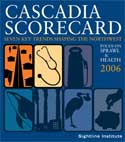
It makes intuitive sense that living in a community that encourages walking—with sidewalks, good street connections, and homes that are close to shops and services—would make you active and healthier.
As Cascadia Scorecard 2006: Focus on Sprawl and Health, Sightline’s just-released annual progress report, points out, such communities are also safer. Residents who live in a compact community have significantly less chance of dying in a car crash—not because they’re better drivers, but because they drive less. (And car crashes, of course, are Cascadia’s leading killer of young people.)
And they also tend to weigh less and have less risk of chronic diseases associated with obesity.
Go the press page for pdfs and fact sheets about the new research. But for a quick take, here are my top ten facts from the new Scorecard:
1. Mile for mile, taking transit is more than 10 times safer than driving a car.
2. Each fatal car crash corresponds to about $5.2 million in direct economic costs.
3. Car crashes cost $5.5 billion in Washington State alone, according to a 2002 estimate by the state DOT. That’s more than the state spends on roads.
4. Downtown Vancouver, BC, has Cascadia’s lowest crash fatality rate. It’s by far the most densely populated part of the Northwest. Though some might associate it with bad congestion—the traffic fatality rate is under one-third the province-wide average.
5. British Columbians are about half as likely to be obese as residents of the Northwest states of Idaho, Oregon, and Washington (12 percent compared to 21 percent), one-third less likely to die in a car crash, and live an average of more than two years longer.
6. A study in King County, Washington, found that pedestrian-friendly neighborhood design was associated with up to a one-point reduction in the body mass index, which can translate in up to 7 fewer pounds of extra body weight.
7. A comparison of two Portland, Oregon, neighborhoods found that a safe and interesting walking environment was linked with higher levels of social capital (basically, trust and connections between community members).
8. For each ten additional minutes a person spends commuting, the time spent involved in community activities falls by 10 percent.
9. When it comes to air quality, residents of low-density suburbs may no longer have an advantage over city dwellers: air monitoring stations in some suburbs find more smog, and comparable levels of other pollutants, than in urban areas.
10. Burning just ten extra calories per day—the amount burned during a two- to three- minute walk—can prevent a pound of weight gain per year.
What are yours?


